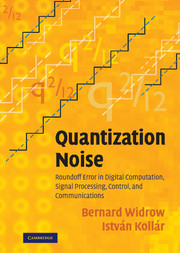 Quantization Noise
Quantization Noise from Part II - Uniform Quantization
Published online by Cambridge University Press: 06 July 2010
In the previous chapter, certain relations between the quantization noise and the quantizer input and output were established. These relations are in the form of moments, particularly crosscorrelations and covariances. These moments are extremely useful for the analysis of quantization and for the analysis of control and signal processing systems containing quantizers. The similarities between quantization and the addition of independent uniformly distributed noise when certain quantizing theorems are satisfied are very useful for analysis of quantization.
The properties of these moments are not totally descriptive of the behavior of the quantizer however, because the quantization noise is deterministically related to the quantizer input, and the moments do not show this. To gain a complete and deeper understanding, we dedicate this chapter to the derivation of joint PDFs and CFs of quantization noise and the quantizer input and output.
JOINT PDF AND CF OF THE QUANTIZER INPUT AND OUTPUT
In this section, we will derive the joint PDF and CF of x and x', i.e. fx,x' (x, x'), and Φx,x' (ux, ux'). The statistical relationship between x and x' is like a statistical version of an input–output “transfer function” for the quantizer.
The derivation will proceed in the following manner. Refer to Fig. 7.1. This figure compares quantization (the addition of actual quantization noise ν to x) with the PQN model (the addition of independent noise n to x).
To save this book to your Kindle, first ensure [email protected] is added to your Approved Personal Document E-mail List under your Personal Document Settings on the Manage Your Content and Devices page of your Amazon account. Then enter the ‘name’ part of your Kindle email address below. Find out more about saving to your Kindle.
Note you can select to save to either the @free.kindle.com or @kindle.com variations. ‘@free.kindle.com’ emails are free but can only be saved to your device when it is connected to wi-fi. ‘@kindle.com’ emails can be delivered even when you are not connected to wi-fi, but note that service fees apply.
Find out more about the Kindle Personal Document Service.
To save content items to your account, please confirm that you agree to abide by our usage policies. If this is the first time you use this feature, you will be asked to authorise Cambridge Core to connect with your account. Find out more about saving content to Dropbox.
To save content items to your account, please confirm that you agree to abide by our usage policies. If this is the first time you use this feature, you will be asked to authorise Cambridge Core to connect with your account. Find out more about saving content to Google Drive.